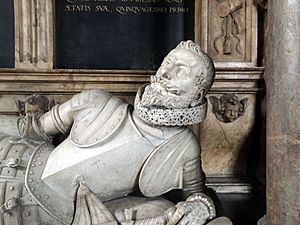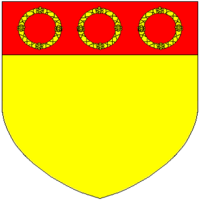Charles Morison (MP for Tavistock) facts for kids

Sir Charles Morrison (also spelled Morison) was an important English politician. He lived during the time of Queen Elizabeth I. He was the heir to the large Cassiobury Estate in Watford, Hertfordshire. Sir Charles was also a Member of Parliament (MP) for Tavistock. This means he was chosen to represent people in the Parliament of England.
Contents
Who Was Sir Charles Morrison?
His Early Life and Family
Charles Morrison was born in 1549. His father was Sir Richard Morrison. His mother was Bridget Hussey. Charles had three sisters: Jane, Elizabeth, and Mary.
His father, Sir Richard, worked as a secretary for the royal court. In 1546, he was given the Cassiobury manor. This land used to belong to St. Albans Abbey. It was taken by the King during the Dissolution of the monasteries.
Sir Richard was sent to be an ambassador to the Holy Roman Emperor. This happened when Edward VI was king. Charles probably lived with his parents in Strasbourg when he was a young child. Sadly, his father died when Charles was only six years old. Charles and his mother, Bridget, then returned to England.
His Mother's Marriages and Education
After Sir Richard died, Charles's mother, Bridget, married again. First, she married Henry Manners, 2nd Earl of Rutland in 1561. He passed away in 1563. Later, in 1566, Bridget married Francis Russell, 2nd Earl of Bedford.
When Charles was young, John Throckmorton became his guardian in 1557. This was not what Charles's father had wanted. His father had hoped Catherine, Duchess of Suffolk, would be his guardian. She shared his religious beliefs.
Charles went to Trinity College, Cambridge in 1564. Then, in 1566, he joined Gray's Inn. This was a place where people studied law.
Sir Charles Morrison's Career
His Role in Parliament
Charles became part of the Earl of Bedford's family. The Earl of Bedford encouraged Charles to become an MP in 1576. Records from Parliament show that he was chosen for a special committee. This committee dealt with taxes on January 25, 1581.
Other Important Jobs
Sir Charles also held several other important positions. From about 1577, he was a Justice of the Peace for Hertfordshire. This meant he helped keep law and order. He was also a sheriff in 1579-1580. A sheriff was a chief law enforcement officer in a county. In 1583, he became the Keeper of Rockingham Forest.
Morrison supported the religious activities of the Puritan Thomas Wilcox. He also helped the young Robert Cecil rise in politics. He was a good friend of Francis Walsingham, another important figure.
Family Life and Legacy
Marriage and Son
In 1573, Charles Morrison married Dorothea. She was the daughter of Nicholas Clerke. Dorothea had been married before to Henry Long. Charles and Dorothea had one son, who was also named Charles. This son later became Sir Charles Morrison, 1st Baronet.
His Death and Burial

Sir Charles Morrison passed away in 1599. His son, young Charles, was only 12 years old at the time. His mother, Bridget, along with Henry, 6th Earl of Kent, and Thomas, Lord Grey of Wilton, became his son's legal guardians.
Young Charles inherited his father's properties. These included lands in Bedfordshire, London, and Cassiobury in Watford. He later became a Member of Parliament himself.
Sir Charles Morrison was buried in a special chapel. This chapel was for the Morrison and Essex families. It is located in St. Mary's Parish Church in Watford. His tomb is very large and detailed. It was made by Nicholas Stone, a famous sculptor. The tomb shows a white marble statue of Sir Charles. He is shown wearing armor and a large Elizabethan ruff around his neck. His family's coat of arms is also on the tomb. Statues of his son and daughter are kneeling at each end. A long Latin message on the tomb describes his good qualities. It also says he was the person who built the chapel.


